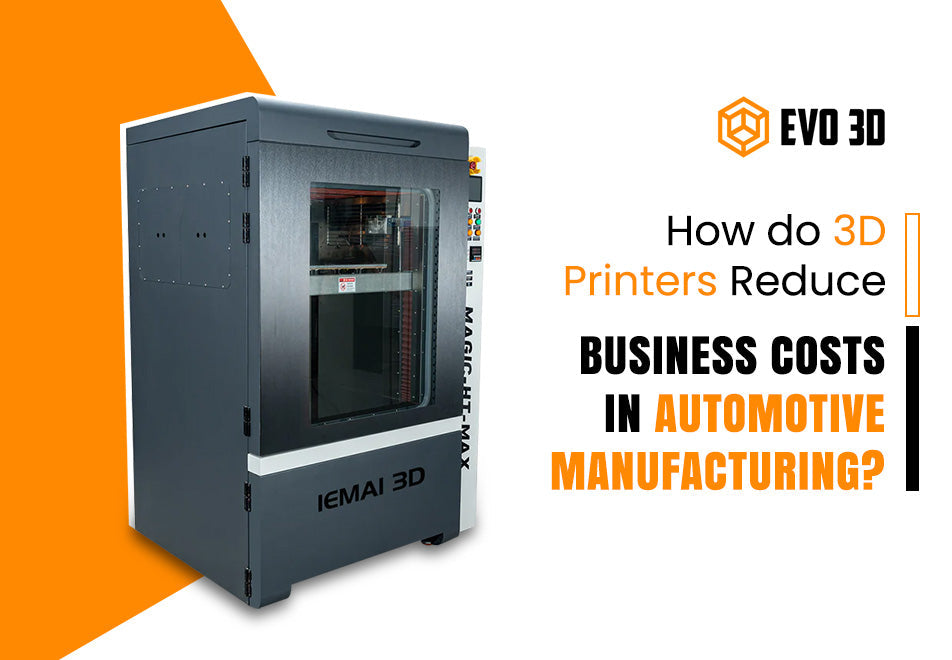How do 3D Printers Reduce Business Costs in Automotive Manufacturing?

We live in an era where electric vehicles have the potential to change the automotive landscape, many automotive companies are competing with each other. Apart from this, they are now prioritising sustainability and cost-efficiency. Manufacturers are tasked with delicately balancing various aspects of the industry, including lean manufacturing and agile design processes. This is where 3D printers come into the picture, as they help reduce waste and shorten lead times. They help accelerate the time to market for new vehicles and parts. In this blog, we will explore how 3D printers help automotive businesses reduce operational costs.
Ways 3D Printers Help Businesses Save Money in Automotive Manufacturing
The automotive industry is growing, and manufacturers are finding new ways to reduce business costs while maintaining high-quality production. It has been seen that there is an increase in electric vehicles and sustainability, and 3D printing has emerged as a game-changing technology. It has helped businesses streamline their operations. Some of the ways 3D printers help save operational costs in automotive manufacturing are as follows:
Rapid Prototyping
Speed to market can make or break a business, especially in the automotive industry. Rapid prototyping with the help of large-format FDM printers shortens the design and development cycle. This enables manufacturers to test new designs quickly so that they find any issues easily and make modifications before moving into large-scale production. 3D printers have made it easier to iterate designs faster, which helps them reduce any costly delays. This allows them to bring new products to the market more quickly.
Manufacturers can create functional prototypes that can be tested under real-life scenarios, ensuring that they perform better and fewer revisions in design are needed. This helps in speeding up the entire development process, saving both time and money.
Improved Design
Additive manufacturing has helped automotive engineers design complex shapes that are not possible using traditional methods of printing. This advanced technology allows engineers to create customised parts more efficiently. As a result, companies can accelerate product development at lower production costs and explore innovative design possibilities with the help of large format FDM printers. It supports rapid prototyping, allowing faster testing and iteration, ultimately driving the growth in the automotive industry.
Customized 3D-Printed Parts
Customisation is one of the important assets in automotive manufacturing. Traditional manufacturing methods often lack the flexibility to produce unique parts efficiently. However, with a 3D printer, manufacturers can create custom components with accuracy without any expensive tooling. This flexibility allows faster turnaround times and helps businesses save money and deliver more innovative design solutions.
Whether companies are building high-performance vehicles, concept cars, or aftermarket parts, with an industrial 3D printer UK, additive manufacturing empowers engineers to deliver personalised, functional parts that improve user experience and product differentiation.
Sustainability
Efficiency is very important in automotive manufacturing, and 3D printing aligns with this goal perfectly. The versatility of 3D printers allows manufacturers to produce parts on demand, reducing overproduction and inventory costs. They use eco-friendly materials that reduce waste and energy consumption.
Many 3D printing materials are also recyclable or derived from sustainable sources, further enhancing eco-friendly production. This is why businesses are using 3D printers for modern automotive development.
On-demand production
The precision of 3D printing allows the production of automotive parts on demand, thus eliminating the need for large inventories of spare parts. This is something not possible without 3D printers, as traditional printers require extensive loading, setup time, and bulk production to remain cost-effective.
This flexibility is especially valuable for producing legacy parts, custom modifications, or low-volume items without interrupting mainstream production lines. Ultimately, on-demand production with the help of large format FDM printers enhances agility, reduces overhead, and aligns with modern just-in-time manufacturing strategies.
Final Thoughts
To conclude, with each passing year automotive industry is continuing to evolve, ultimately driving improvements in the world of 3D printing. 3D printers are not only streamlining production but also allowing more growth and innovation in the automotive industry. The future of automotive manufacturing is being reshaped with the possibilities of 3D printers.
Are you looking for printers for your business needs? You can reach out to Evo3D for advanced printing solutions tailored to your industry.
